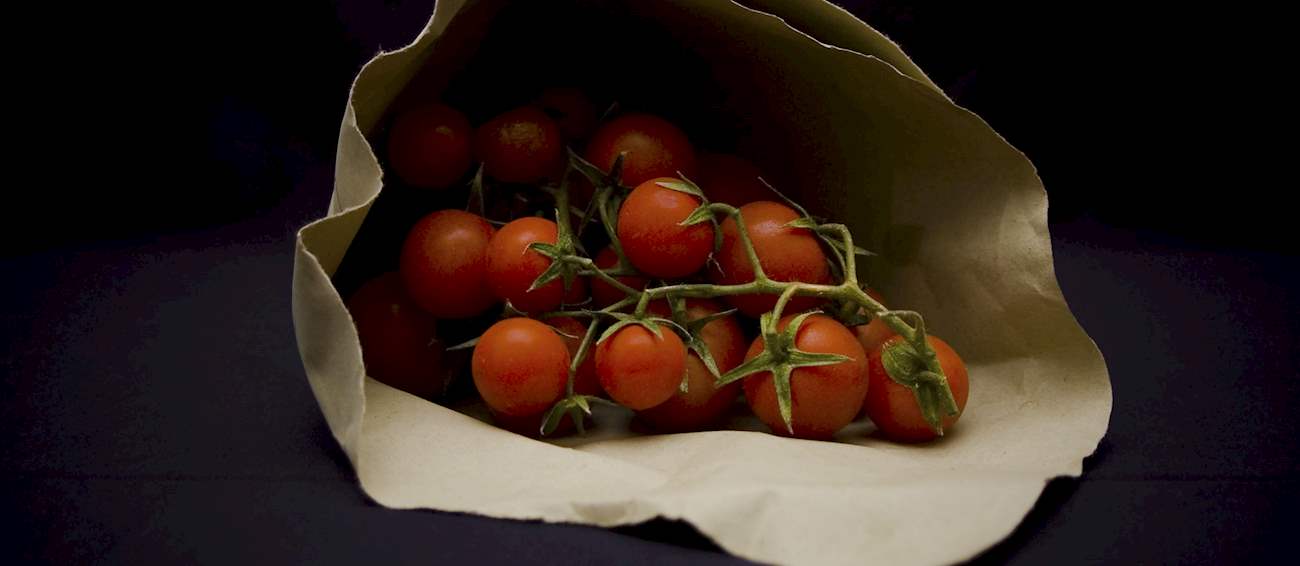Best European Fruit Vegetable Types
These small tomatoes come from a local variety produced on the islands of Santorini, Thirasia, Palea Kameni, Nea Kameni, Aspro, Christiani, and Askania in the Cyclades in the southern Aegean Sea. The production, treatment, and processing of these tomatos must be carried out exclusively within this area in order to avoid deterioration in the quality of this fragile fruit.
Tomataki Santorinis is a deep red color and has a firm, not particularly moist flesh with a high seed content. These tomatoes owe their distinctive characteristics to the climatic conditions and the limey, alkaline soils of the area. It has high levels of acidity and, due to the alkaline soil, a high sugar level when ripe.
Named after its town of origin, pomodoro di Pachino refers to various varieties of fresh tomatoes grown within the Sicilian province of Syracuse. The sweet flavored Pachino tomatoes are characterized by a particularly succulent flesh and prized for their long shelf life.
They are best enjoyed fresh, and typically used as an ingredient for mixed salads, cold pasta dishes or for pizza toppings. Also, according to old Sicilian culinary traditions, Pachino tomatoes are often sun-dried and preserved in olive oil in which way they can be used for making pâtés and tapenades, various flans and a seemingly limitless number of pasta dishes.
Prized by many chefs as the best of its kind, Pomodoro S. Marzano dell’Agro Sarnese-Nocerino is a variety of plum tomato grown along the banks of Sarno River in the fertile volcanic plains south of Mount Vesuvius, namely within the provinces of Naples, Salerno and Avellino.
Locally known as 'the king of tomatoes', San Marzano peels quite easily and is characterized by an almost seedless flesh, bright red color and a delicate, bittersweet flavor. Even though San Marzano tomatoes are commonly used in a wide variety of Italian dishes, they have been designated as the only tomato variety that can be used for Vera Pizza Napoletana, the genuine Neapolitan pizza.
Grown and produced in the province of Naples, namely within the Vesuvio National Park, Pomodorino del Piennolo del Vesuvio refers to cherry tomatoes which are marketed al piennolo, braided in bunches and sun-dried. As the tomatoes slowly dry out, their sweet flavor and aroma become more intense and concentrated.
Thanks to this old Vesuvian method of preserving, these fragrant cherry tomatoes can be enjoyed year round. Piennolo tomatoes are amazingly versatile and typically used as pizza topping or for preparing a wide variety of traditional Neapolitan pasta dishes like Scialatielli con salsiccia and Tagliatelle alle vongole or even desserts such as Millefoglie del Vesuvio.
Florina is a Greek pepper cultivated in Western Macedonia and the area of Florina, hence the name. The peppers have a deep red color and they're shaped like a cow's horn. The harvest takes up to 18 weeks, and they ripen to maturity after mid-August.
It is said that a good Florina pepper should be firm, thick, bright in color, and sweet in flavor. These versatile peppers can be used in salads, sauces, pasta dishes, or meat dishes, but they're usually roasted and stuffed with ingredients such as feta, meat, rice, or shrimps.
Costoluto fiorentino is a tomato variety originating from Florence. This heirloom has a distinct flattened and heavily ribbed shape. When mature, the color of the tomato is a brilliant deep red. These tomatoes have a meaty and juicy texture that is high in sugar and acid, making them one of the best varieties for cooking and making rich sauces or soups such as pappa al pomodoro.
They are also used fresh, sliced and added to sandwiches or salads.
Ajvarka is one of the oldest North Macedonian pepper varieties, and its official name is Kurtovska kapija (Kurt gate). However, people call it Ajvarka because it is most commonly used to prepare the famous red pepper relish called ajvar. This pepper contains a small amount of water, it has a thin shell, and it peels very well, which is important for preparing ajvar, although the pepper can also be eaten raw or used in other dishes.
Ajvarka is usually flat, has a thin handle on top, and it's often heart-shaped. Regarding the size, it's not bigger than a woman's palm. It is believed that the best type of this pepper is the one that ripens from September 10 to September 25.
Piment d'Espelette is a fiery red, hand-picked chili pepper with a strong smell reminiscent of fruit and smoke, produced in the Pyrénées-Atlantiques region in France. It was originally used in the south-west of France for curing dried ham.
Their taste is spicy and piquant, but not too hot on the palate. It can be sold in a few ways - as fresh, whole peppers strung in pairs of twos, threes, or fours on a string, or ground into orangey-red chili powder after the peppers have ripened enough.
Padrón pepper is a Galician pepper originating from the Padrón municipality. The peppers range in color from bright green to yellowish green. Although they are usually mild in flavor, about one in ten of these peppers is spicy as hell, but it's almost impossible to tell them apart until you taste them, which is like playing Russian roulette with peppers.
Padrón peppers are traditionally fried in olive oil and seasoned with coarse sea salt. They are served in most tapa bars and restaurants in the region, and it's recommended to have a glass of beer, wine, or cider nearby - in case you eat a few of the spicy ones.
This eggplant is produced exclusively in Arcadia prefecture near the town of Leonidio. These purple, slightly curved aubergines with unusual white stripes are cultivated outdoors on the sandy soils of the area. They are harvested from May to November.
What sets them apart from other eggplant varieties is their white stripes and their very mild, almost sweet taste with a lack of bitterness. Tsakoniki Melitzana Leonidiou is used as a basic ingredient in many recipes, and is often prepared as 'melitzanaki', a spoon sweet.
Best European Fruit Vegetable Producers
AWARDS

Global Cheese Awards - Gold
2023, 2018

World Championship Cheese Contest - Best of Class
2024, 2022, 2020, 2018, 2016, 2014, 2012, 2010

International Cheese Awards - Gold
2024, 2023, 2022, 2019
BEST Arla Cheeses
AWARDS

Great Taste Awards - 2 stars
2024, 2022
BEST Hodi Paprika Herbs and Spices
Best European Fruit Vegetables
AWARDS

World Championship Cheese Contest - Best of Class
2024
AWARDS

Great Taste Awards - 2 stars
2024
TasteAtlas food rankings are based on the ratings of the TasteAtlas audience, with a series of mechanisms that recognize real users and that ignore bot, nationalist or local patriotic ratings, and give additional value to the ratings of users that the system recognizes as knowledgeable. TasteAtlas Rankings should not be seen as the final global conclusion about food. Their purpose is to promote excellent local foods, instill pride in traditional dishes, and arouse curiosity about dishes you haven’t tried.










































